#pioneer stereo equipment
Explore tagged Tumblr posts
Text

From the classic audio files: 1976/1977 Pioneer HiFi Stereo equipment product brochure. Interior panels - loudspeaker systems.
#vintage advertising#vintage brochures#vintage hifi#vintage stereo#vintage electronics#stereo systems#hifi equipment#pioneer#pioneer electronics#pioneer stereo#pioneer stereo equipment#hi-fi#hifi#stereos#vintage pioneer#vintage pioneer speakers#vintage pioneer receivers#vintage pioneer turntables
5 notes
·
View notes
Photo

559 notes
·
View notes
Photo

Ah, the aroma of brand new stereo equipment as it warms up for the first time. The smell of music and good times. I call it electrichor.
1969
#vintage ads#vintage ad#advertising#advertisment#1969#stereo equipment#pioneer#1960s ad#1960's#1960s#1960's ad#funny#humor#humour
9 notes
·
View notes
Text

1964 Buick Riviera

1964 Buick Riviera
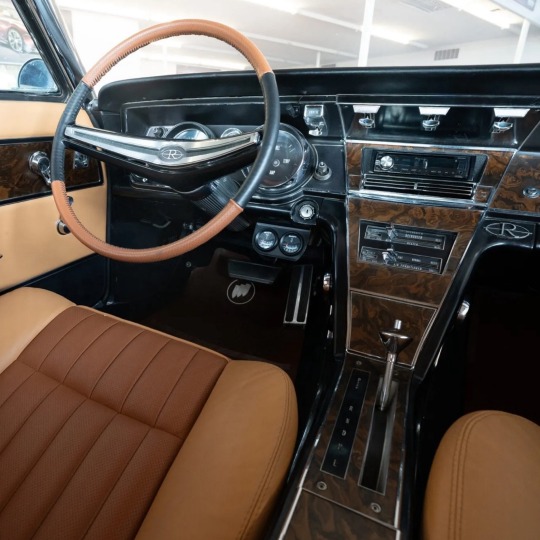
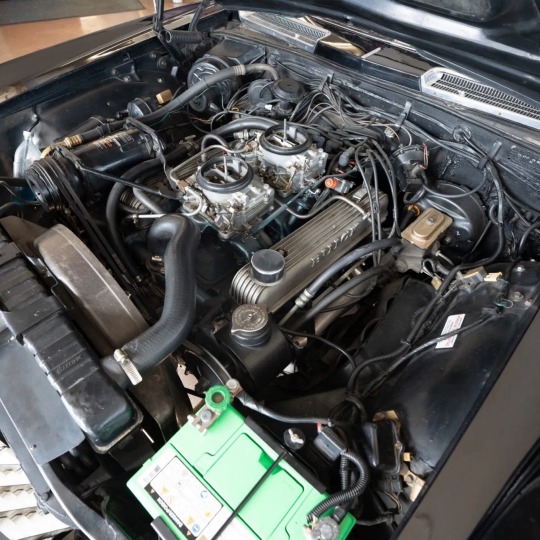
1964 Buick Riviera
Super Wildcat
This 1964 Buick Riviera was refurbished in 2014, which included refinishing the body in black and trimming the interior in two-tone brown leather. It is powered by a 425ci Super Wildcat V8 with dual four-barrel carburetors mated to a three-speed automatic transmission.
Equipment includes 17″ aftermarket five-spoke wheels, lowered suspension, a dual-exhaust system, quad round headlights, rear bucket seats, air conditioning, and an aftermarket sound system with a Pioneer CD stereo.
311 notes
·
View notes
Text
1968 Gen X HIM [MICHAEL] 2024 KING... PIONEERED HIS Own Trail [HOT] before 1921 during 1999 Y2K 2000… since Mayan’s 2012 Afterlife Prophecy [MAP] Predate sunken place 2023 america
IMMORTAL U.S. MILITARY KING SOLOMON- MICHAEL HARRELL, JR.™

OMMMMM

1968 Gen X HIM [MICHAEL] WEALTHY like KING TUT!!!

HIM first name: MICHAEL last name: HARRELL suffix: Jr... 1st clandestine electronic business name in stereo & hi fi [hi tek] equipment in over 65 countries of anu 2024 golden 9 ether world order @ Highly Official… U.S. ��giptian [HOUSE] Deutsch QUANTUM HARRELL TECH [QHT] LLC

1968 Gen X HIM [MICHAEL] KING... PIONEER

eye legally [el] patent everything around HARRELL since Commerce Rules Everything Around MICHAEL [CREAM]

Bildwissenschaft!!!
#om#o michael#quantumharrelltut#quantumharrelltech#harrelltut#mu:13#kemet#hamburg#pioneer#München#bildwissenschaft
1 note
·
View note
Text
The Evolution of JVC: A Comprehensive History of Innovation and Influence

Introduction Japan Victor Company, better known as JVC, is a name synonymous with innovation in the world of consumer electronics. From pioneering advancements in the world of audio and video technology to creating some of the most iconic consumer products of the 20th century, JVC has played a crucial role in shaping the way we experience media today. This blog post delves into the fascinating history of JVC, tracing its journey from its early beginnings to its impact on the modern tech landscape. 1. The Founding of JVC JVC was founded in 1927 in Yokohama, Japan, as a subsidiary of the U.S.-based Victor Talking Machine Company, the largest and most successful manufacturer of phonographs and phonograph records in the early 20th century. The original purpose of JVC was to produce phonographs for the Japanese market, leveraging the parent company's technology and expertise. In 1929, JVC began manufacturing records, starting with pressing the first shellac records in Japan. The company quickly became a significant player in the Japanese market, known for high-quality products that brought music into homes across the country. 2. Early Innovations and World War II In the 1930s, JVC expanded its product line to include radios, reflecting the growing demand for new forms of entertainment. By 1939, the company had developed Japan's first phonograph record, "His Master's Voice," which became an iconic product symbolized by the image of a dog listening to a gramophone. During World War II, like many companies, JVC's operations were significantly impacted. The company shifted its focus to producing wartime electronics, including communications equipment for the Japanese military. Despite these challenges, JVC continued to innovate, laying the groundwork for post-war success. 3. Post-War Recovery and Technological Breakthroughs After World War II, JVC resumed its consumer electronics production, quickly becoming a pioneer in the industry. In 1953, the company introduced Japan's first EP (Extended Play) record, and in 1956, it produced Japan's meanwhile first LP (Long Play) record. These advancements were crucial in popularizing recorded music and home entertainment in Japan. One of JVC's most significant contributions to the world of audio technology came in the early 1960s when it introduced the 45/45 stereo record system. This system, which became the global standard for stereo records, was a major breakthrough, enabling the widespread adoption of stereo sound in homes. 4. The VHS Revolution The 1970s marked a turning point for JVC, with the company's most famous and influential invention: the VHS (Video Home System) format. Developed in 1976, VHS quickly became the global standard for home video recording and playback, outpacing competing formats like Betamax. JVC's decision to license the VHS format to other manufacturers was a key factor in its widespread adoption. By allowing other companies to produce VHS-compatible devices, JVC ensured that the format became ubiquitous, dominating the home video market for decades. VHS not only transformed home entertainment but also had a profound impact on the movie industry, enabling the rise of video rentals and home movie collections. 5. Expansion and Diversification in the 1980s and 1990s Buoyed by the success of VHS, JVC continued to expand its product offerings throughout the 1980s and 1990s. The company ventured into the realm of audio equipment, producing high-quality amplifiers, speakers, and portable audio devices, including the popular "Boom Box" systems. In the realm of video technology, JVC was also at the forefront of innovation. In 1984, the company introduced the world’s first compact VHS-C camcorder, which became incredibly popular for home video recording. The camcorder was smaller and more portable than previous models, making it easier for consumers to capture memories on the go. During the 1990s, JVC further expanded its influence in the digital age, developing digital video formats such as the D-VHS (Digital VHS) and the D-Theater format, which offered high-definition video playback. Although these formats did not achieve the same level of success as VHS, they were significant steps in the transition from analog to digital media. 6. The Digital Age and Beyond As the world entered the digital age in the 2000s, JVC faced new challenges. The decline of VHS due to the rise of DVDs and later, Blu-ray discs, marked the end of an era. However, JVC adapted by shifting its focus to digital technologies, including LCD televisions, digital camcorders, and professional video equipment. In 2008, JVC merged with Kenwood Corporation to form JVCKenwood, a move that allowed both companies to pool their resources and expertise in the highly competitive electronics market. This merger marked a new chapter in JVC's history, as the company continued to innovate in the fields of car audio, professional video equipment, and home entertainment systems. 7. JVC’s Legacy and Impact on Modern Technology Today, JVC's legacy is evident in many aspects of modern technology. The company's contributions to the development of home entertainment, particularly through the VHS format, have had a lasting impact on how people consume media. JVC's commitment to innovation, from the early days of phonographs to the digital age, has made it a significant player in the global electronics industry. Although the brand is not as dominant as it once was, JVC continues to be respected for its quality products and its role in the history of consumer electronics. The company's influence can be seen in the evolution of home entertainment, recording technology, and audio-visual systems. Conclusion JVC's journey from a phonograph manufacturer in 1927 to a global leader in consumer electronics is a testament to its innovative spirit and resilience. The company's ability to adapt to changing technologies and markets has ensured its place in the annals of tech history. As we continue to advance into the digital era, JVC's contributions to the world of audio and video technology will be remembered as milestones that shaped the way we experience media today. Read the full article
0 notes
Text
B&W Speakers
Bowers & Wilkins, commonly known as B&W, has established itself as a prominent name in the world of audio equipment. Renowned for their precision engineering and commitment to high-fidelity sound, B&W speakers have become synonymous with premium audio experiences. This article explores why B&W speakers are not just great to use but also valuable investments for audio enthusiasts and professionals alike.
Legacy of Excellence in Audio Engineering
Bowers & Wilkins traces its roots back to 1966, when John Bowers and his team began crafting speakers in the English countryside. Since then, B&W has earned a reputation for pioneering technologies that redefine audio quality. Their commitment to innovation has resulted in numerous patents and industry awards, solidifying their position as leaders in the field.
High-Fidelity Sound Reproduction
At the heart of B&W speakers lies a dedication to achieving true-to-life sound reproduction. Whether it's their flagship floor-standing models or compact bookshelf speakers, B&W utilizes advanced acoustic engineering techniques to minimize distortion and deliver clear, natural audio. This fidelity is particularly valued by audiophiles who demand studio-grade performance from their home audio setups.
Superior Build Quality and Materials
One of the hallmarks of Bowers & Wilkins speakers is their meticulous craftsmanship and use of premium materials. From the selection of high-density woods for cabinet construction to the precision-engineered drivers and tweeters, every component is designed to enhance sound quality and durability. This attention to detail not only ensures superior acoustics but also contributes to the aesthetic appeal of B&W speakers in any living space.
Versatility Across Audio Environments
Whether you're setting up a dedicated home theater, a cozy listening room, or integrating speakers into a multi-room audio system, B&W offers a diverse range of products to suit various environments and preferences. Their speakers are engineered to perform optimally across different setups, providing flexibility without compromising on audio excellence.
Innovative Technology Integration
B&W continually pushes the boundaries of audio technology with innovations like their diamond dome tweeters, which leverage synthetic diamond for superior treble reproduction. They also integrate advanced crossover designs and bass technologies to achieve a balanced sound signature that is both dynamic and immersive. Such technological advancements underline B&W's commitment to staying at the forefront of audio innovation.
Recognition and Industry Awards
Over the decades, Bowers & Wilkins has garnered widespread acclaim from audio critics and enthusiasts alike. Their speakers have consistently received accolades for their exceptional sound quality, innovative design, and contribution to advancing audio technology. This recognition not only validates the brand's commitment to excellence but also reinforces the trust placed in B&W by professionals and consumers worldwide.
Customer Satisfaction and Support
Beyond their products, B&W prides itself on delivering exceptional customer satisfaction and support. Whether it's providing detailed setup guidance, offering warranty services, or assisting with technical queries, B&W ensures that their customers receive the assistance they need to fully enjoy their audio experiences. This dedication to service contributes to the overall value proposition of owning Bowers & Wilkins speakers.
Conclusion
In conclusion, B&W speakers stand out not only for their exceptional sound quality and innovative engineering but also for their enduring legacy of craftsmanship and customer satisfaction. Whether you're a discerning audiophile, a professional sound engineer, or simply someone who appreciates premium audio experiences, Bowers & Wilkins offers a range of speakers that combine technological prowess with artistic elegance. Investing in B&W speakers isn't just about acquiring audio equipment; it's about embarking on a journey of sonic discovery and enjoying music the way it was meant to be heard. By choosing B&W, you're not just purchasing speakers – you're investing in a tradition of excellence that continues to redefine what's possible in audio reproduction. From their iconic designs to their uncompromising commitment to quality, Bowers & Wilkins remains a benchmark of audio perfection, setting the standard for generations to come.
1 note
·
View note
Text
Best Car Stereo Installation in Houston to Upgrade Your Sound System
Whether you are looking to improve the sound system in your car or just looking for a way to enhance the Bass the market has plenty of items that you could opt for, but to get the best, it is advisable to visit the Best Installation in Houston.
Houston has you covered! Is your car’s sound system subpar? Does it lack the oomph factor to make your daily drive exciting? It could be time to upgrade your car stereo in Houston. How do you get started, though, when it comes to selecting car stereos in Houston and finding a provider of car stereo installation services?
This article is designed to be your roadmap into the incredible and rather vast universe of car audio houston. We will provide recommendations of the best technicians for the installation of car stereos and explain some of the factors one needs to contemplate while choosing car stereo in houston.
Finding the Perfect Sound for You
Houston has numerous shops that deal in car stereo and they cover a very broad market with different things and brands available. Whether you go for the bass-intensive beats or the sound-audiophile mission, there’s equipment for every one and every pocket.
Here are some things to keep in mind while browsing car stereos in Houston.
Features: Do you desire to host calls and stream music with no cables and wires involved? To this, it is recommended that one should look for a stereo that is Bluetooth compatible. Interested For Preparing A Roadmap For New Streets: A device they use often and has a GPS system could help in tracking them.
Sound Quality: Think of the number of speakers and subs that you ought to use.
This leads into the next point with regard to the requirements of the desired number of speakers and subwoofers. More speakers in effect offer a clearer sound profile while subs Embedded that deep bass.
Brand: Pioneer, Kenwood, Alpine, and JBL are some of the many car stereo brands that can be found. Before moving on, read some reviews for each of these brands to determine what their online reputation is for offering high-quality products and good customer experience.

Expert Car Stereo Installation in Houston
After that you make your mind up and decided which car stereo is your dream car stereo you need, it is high time to find the perfect Houston shop for installation. Here's what to look for Here's what to look for.
Experience: Inquiring about the level of experience of the shop and its mechanics and whether or not they are particularly knowledgeable about various car brands and manufacturing companies. It is the work of a professional installer to observe hygiene and facilitate an aesthetic appearance of a well set installation.
Warranty: Ensure that the shop facilitates delivery of warrant on the installation as well as the car stereo.
Customer Reviews: See the odd reviews of other clients to have an idea on what they have to say.
Houston's Hidden Gems
Aside from those giants, there are many other shops not so well-known but employing the best professionals in their field and offering reasonable prices for car stereo installation. Of course, you should not be shy and search for more information about the car or just go to your friends or people who are fond of cars and ask them about their suggestions.
Making Houston car audio upgrades is one of the best ways to make sure that your car investment will give you better and more enjoyable riding for many years to come. Following this guide and the continued research right here will ensure you’re rocking down the highway in no time.
1 note
·
View note
Text
What Does a Car Amplifier Do?
When you're driving and the audio system isn't generating clear sound, how depressing is that? Installing car amplifiers is the only way to enjoy the best sound possible while driving. Without a doubt, the sound system in your car will sound better.
Any sound system that wants to increase the power of the signal needs an amplifier. In your car, it operates in the same manner.
Installing a car amplifier in South Africa is the finest way for someone to improve the audio quality. Usually, musical instruments or stereo equipment are referred to as "amplifiers." They are present in a wide range of different gadgets that use speakers to emit sound, such as portable CD players, laptops, televisions, and many more.
To maintain the sound quality of your vehicle's entertainment and audio system, you require a car audio amplifier. This is the main feature of any state-of-the-art sound system.
Your car audio amplifier still powers your sound system. In technical terms, the amplifier changes the power that the vehicle's battery produces. With the help of the speaker inputs, it can perfectly synchronize your sound system with high-frequency sounds and deep bass beats. An amplifier is an essential for any audio system containing subwoofers in order to provide the power required for the subwoofers to perform as intended.
How automobile audio amplifiers differ from each other is based on the number of channels they have. Although some amplifiers can have up to eight channels, the majority of variants have two to four channels. Four channels are usually plenty for subwoofers, though this also depends on their size. A two- or four-channel amplifier will do for a car's full-range audio system. It takes extra channels, up to four or six, to use speakers and subwoofers together.
If you know a little bit about automotive audio wiring, connecting an amplifier to your car's audio system is not too difficult. An amplifier bridge is most commonly used to connect two amplifiers with subwoofers. If your amplifier has four channels, connect a pair of 4-ohm subwoofers to it. This is one method of bridging amplifiers to produce high-quality audio. Thus, Pioneer is a respected car audio brand in the market if you're searching for the greatest car audio quality amplifiers to enhance the sound quality of your vehicle's audio system. They feature an enormous assortment of well-priced, premium collections.
One retailer of electronics for vehicle audio systems, video audio amplifiers, subwoofers, etc. is Pioneer. Pioneer is among the greatest online merchants if you're looking to buy a dependable amplifier. The greatest car android auto in South Africa and other relevant car radio accessories are available when you visit them.
#car audio system dubai#car audio#car audio dubai#car sound system dubai#car audio system#car subwoofer for sale in dubai
0 notes
Text
Anaglyphs by Joseph Charles d'Almeida (Paris 1822 – Paris 1880).
I was distantly related to the physicist from Almeida who was a great uncle of my grandfather, what I have left of him are photos representing him...
The first public projections of stereoscopic views were made possible thanks to the invention of Joseph Charles d'Almeida. The latter projects the images through a magic lantern using colored filters and distributes glasses with these same filters (red and green) to the spectators. This invention was perfected and is still used today in the so-called anaglyph process. (1).
In 1858, the French physicist Joseph – Charles d'Almeida invented the first relief slide projection process, anaglyphs. For the selection of left and right images (stereoscopic pair), two complementary colors are used, red and blue (cyan). This process with red and cyan glasses is still used today. (2).
The photographer specializing in stereoscopy, Isaac Georges Lévy (Hégenheim 1833 – 1916 Paris) had his stereoscopic photo workshop in Paris (Cf. Photo from the Roger Viollet Collection), the photographer Roger Viollet cannot be in a paper medium for reasons legal. (3).
During the late 1850's, Joseph Charles d'Almeida had been developing a way to view images in 3 D by using the anaglyph method. He and Louis Ducos Du Hauron (Langon 1837 – 1920 Agen) gave the first anaglyph presentation in 1858, using makeshift color lenses as 3D glasses. (4).
Through Stereoscopy, Laes Anaglyphes, MM Charles d'Almeida, Mr. Georges Lévy and Mr. Gabriel Lppmann (1845 – 1921) are among the pioneers of stereoscopic photography which will give rise to relief films. (5).
Joseph Charles d'Almeida (Paris 1822 - Paris 1880) proposed in 1858 relief projection on screen, in anaglyuph, according to Rollman's process, using two projectors (two "magic lanterns") equipped with red filters and green or yellow and cyan. (6).
In 1858, Joseph Charles d'Almeida, a physics professor at the Lycée Henri IV in Paris, invented a method for showing stereoscopic images to several people at once using a lantern projector equipped with red and blue filters. . Spectators wore red and blue glasses. (7).
Stereoscopy invented by Charles Wheatone in 1838 has many variations but only the process using color filtering, developed by the German Wilhelm Rollman in 1853 and later called anaglyph, makes it possible to print in a single image, which can be of large format, the information necessary for relief vision, which is obtained by means of filter glasses. Charles d'Almeida presented this technique at the Paris Academy of Sciences in July 1858 and was interested in its improvement. His research will open the way to strobostereoscopy, a method applicable to cinema and using the alternation of filtered views of two complementary colors. (8).
Research by Franck d'Almeida.
Source :
(1): Press kit Chamonix d’Antan in 3D (October 18, 2014 – March 29, 2015° Contact: Lucinda Perrillat – [email protected]
(2): https://areq.net/lang/fr/Cin%C3%A9ma_en_relief.html
(3) https://www1.alliancefr.com/actualites/autour-du-photographe-isaac-georges-levy-6050838, article by Franck d’Almeida.
(4) https://id.pinterest.com/pin/during-the-lat-1850s-josph-dalmeida-had-been-developing-a-way-to-view-images-in-3d-by-suing -the-anaglyph-method-h--20336635798181228
(5) http://judaisme.sdv.fr/perso/industrie/glevy/glevy.htm
(6) https://www.image-en-relief.org/stereo/193-glossaire
(7) https://earthobservatory.nasa.gov/blogs/earthmatters/2016/11/21/what-on-earth-is-an-anaglyph. & www.almyimages.fr.photos-images/magic-lantern.html?sortBy=relevant
(8) Text by Franck d'Almeida in the Bulletin of the Friendly Association of Former Students of the Lycée Henri IV. September 2021.
Les Anaglyphes par Joseph Charles d'Almeida (Paris 1822 – Paris 1880).
J'ai eu lointaine parenté avec le physicien d'Almeida qui fut un grand oncle de mon grand père, de ce qu'il me reste de lui c'est des photos le représentant...
Les premières projections, en public, de vues stéréoscopiques sont rendues possibles grâce à l'invention de Joseph Charles d'Almeida. Ce dernier projette les images à travers une lanterne magique utilisant des filtres colorés et distribue aux spectateurs des lunettes disposant de ces mêmes filtres (rouge et vert). Cette invention a été perfectionnée et est encore utilisée aujourd'hui dans le procédé dit anaglyphe. (1).
En 1858, le physicien français Joseph – Charles d'Almeida invente le premier procédé de projection de diapositive en relief, les anaglyphes. Pour la sélection- des images gauche et droite (couple stéréoscopique), deux couleurs complémentaires sont utilisées, le rouge et le bleu (cyan). Ce procédé à lunettes rouge et cyan est encore actuellement utilisé. (2).
Le photographe spécialisé en stéréoscopie, Isaac Georges Lévy (Hégenheim 1833 – 1916 Paris) avait son atelier de photo stéréoscopique à Paris (Cf. Photo de la Collection Roger Viollet), la photographe Roger Viollet ne peut pas être dans un support papier pour des raisons juridiques. (3).
During the late 1850's, Joseph Charles d'Almeida had been developping a way to view images in 3 D by using the anaglyph method. He and Louis Ducos Du Hauron (Langon 1837 – 1920 Agen) gave the first anaglyph presentation in 1858, using makeshift color lenses as 3D glasses. (4).
Par la Stéréoscopie, laes Anaglyphes, MM Charles d'Almeida, M. Georges Lévy et M. Gabriel Lppmann (1845 – 1921) font partie des pionniers de la photographie stéréoscopique qui donnera naissance aux films en reliefs. (5).
Joseph Charles d'Almeida (Paris 1822 – Paris 1880) a proposé en 1858 la projection en relief sur écran, en anaglyuphe, selon le procédé de Rollman, à l'aide de deux projecteurs ( deux « lanternes magiques ») équipés de filtres rouge et vert ou jaune et cyan. (6).
En 1858, Joseph Charles d'Almeida, professeur de physique au Lycée Henri IV à Paris, a inventé une méthode permettant de montrer des images stéréoscopiques à plusieurs personnes à la fois à l'aide d'un projecteur lanterne équipé de filtres rouges et bleues . Les spectateurs portaient des lunettes rouges et bleues. (7).
La stéréoscopie inventée par Charles Wheastone en 1838 connaît de nombreuses variantes mais seul le procédé utilisant un filtrage des couleurs, élaboré par l'allemand Wilhelm Rollman en 1853 et plus tard appelé anaglyphe, permet d'imprimer en une seule image, qui peut être de grand format, l'information nécessaire à une vision en relief, que l'on obtient au moyen de lunettes filtrantes. Charles d'Almeida présente cette technique à l'Académie des Sciences de Paris en juillet 1858 et s'intéresse à son perfectionnement. Ses recherches vont ouvrir la voie de la strobostéréoscopie, méthode applicable au cinéma et utilisant l'alternance de vues filtrées de deux couleurs complémentaires. (8).
Recherche par Franck d'Almeida.
Source :
(1) : Dossier de presse Chamonix d'Antan en 3D (18 octobre 2014 – 29 mars2015° Contact : Lucinda Perrillat – [email protected]
(2) : https://areq.net/lang/fr/Cin%C3%A9ma_en_relief.html
(3) https://www1.alliancefr.com/actualites/autour-du-photographe-isaac-georges-levy-6050838 , article par Franck d'Almeida.
(4) https://id.pinterest.com/pin/during-the-lat-1850s-josph-dalmeida-had-been-developping-a-way-to-view-images-in-3d-by-suing-the-anaglyph-method-h--20336635798181228
(5) http://judaisme.sdv.fr/perso/industrie/glevy/glevy.htm
(6) https://www.image-en-relief.org/stereo/193-glossaire
(7) https://earthobservatory.nasa.gov/blogs/earthmatters/2016/11/21/what-on-earth-is-an-anaglyph. & www.almyimages.fr.photos-images/magic-lantern.html?sortBy=relevant
(8) Texte de Franck d'Almeida dans le Bulletin de l'Association Amicale des Anciens Elèves du Lycée Henri IV . Septembre 2021.
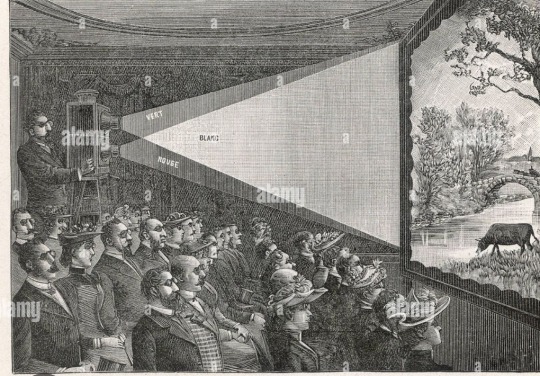


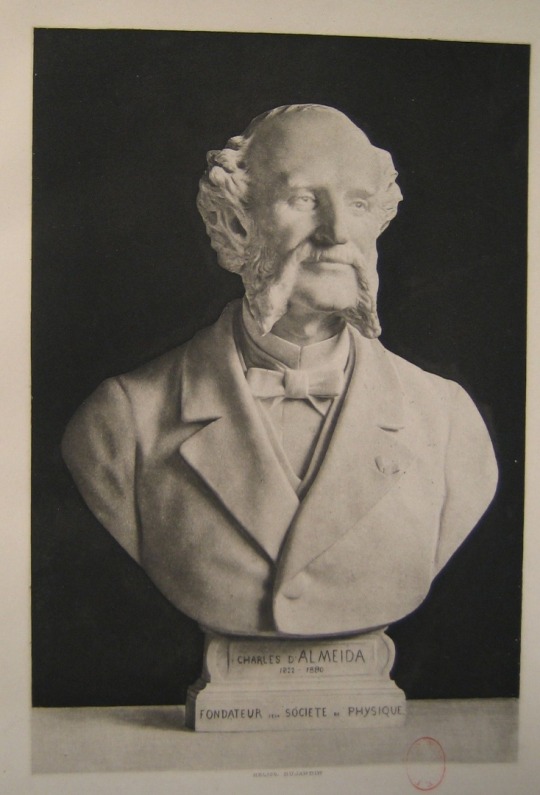



Envoyé depuis l'application Mail Orange
#Fédérationfrancaisedephotographie#Societefrancaisedephotographie#nasa#edpsciences#cnrs#societefrancaisedephysique
0 notes
Text
Unveiling the Audiophile Paradise: A Deep Dive into Koss SB45 and Beyond
In the realm of audio excellence, Koss stands tall as a beacon of innovation and quality. Among its stellar lineup, the Koss SB45 headphones have carved a niche for themselves, offering a harmonious blend of comfort, performance, and style. In this article, we’ll not only dissect the SB45 but also embark on a sonic journey through the diverse landscape of Koss’s product offerings, delve into a brand review, and analyze the prevailing market trends.
Koss SB45: Unveiling an Auditory Gem
Let’s begin our exploration with the star of the show – the Koss SB45 headphones. These over-ear wonders are not merely audio accessories; they are portals to a world where every note, beat, and melody is delivered with pristine clarity. The plush ear cushions and adjustable headband ensure a snug fit, making long listening sessions a joy.
Key Features:
Crystal Clear Audio: Powered by high-quality drivers, the SB45 delivers a rich and immersive audio experience. Whether you’re gaming, streaming, or just enjoying music, every sound is rendered with precision.
Built for Comfort: The ergonomic design and soft ear cushions make the SB45 a pleasure to wear for extended periods. Say goodbye to discomfort during those marathon gaming sessions or work calls.
Durable Build: Crafted with durability in mind, the SB45 is a reliable companion for the long haul. The sturdy construction ensures these headphones can withstand the rigors of daily use.
Beyond the SB45: A Symphony of Choices
Koss’s repertoire extends far beyond the SB45, offering a diverse array of audio solutions to cater to every audiophile’s taste. From the iconic Porta Pro to the powerful UR40, Koss has a product for every discerning ear.ModelTypeKey FeaturesSuitable ForPorta ProOn-EarLightweight, FoldableCommuters, On-the-goUR40Over-EarOpen-Back Design, Studio QualityStudio MonitoringKPH30iOn-EarComfortable, Warm Sound SignatureCasual Listening
Koss: A Brand Odyssey
A brand is more than just a name; it’s a legacy. Koss, with its roots tracing back to 1958, has etched its name in the annals of audio history. Renowned for its pioneering work in stereo headphones, Koss has consistently pushed the boundaries of innovation.
The Koss Advantage:
Commitment to Quality: Koss has always been synonymous with quality. Each product undergoes rigorous testing to meet the highest standards, ensuring that customers receive nothing short of excellence.
Innovation as a Tradition: From the first stereo headphones to the latest wireless offerings, Koss has been at the forefront of audio innovation. The company’s commitment to staying ahead of the curve is evident in its diverse product range.
Market Trends: Riding the Sonic Wave
The audio landscape is ever-evolving, with trends that shape the way we experience sound. Koss, with its finger on the pulse, continues to adapt and innovate. From the rise of wireless technology to the growing demand for audiophile-grade equipment, Koss remains a stalwart in the dynamic audio market.
Crafting Your Sonic Symphony
In conclusion, Koss isn’t just a brand; it’s an invitation to craft your sonic symphony. Whether you’re seeking the immersive experience of the SB45 or exploring the diverse product lineup, Koss has something to offer every music enthusiast.
So, dive into the world of Koss, where innovation meets tradition, and let your ears be the judge of true audio bliss.
Ready to embark on your audio journey? Discover Koss today!
0 notes
Text

From the classic audio files: 1976/1977 Pioneer HiFi Stereo equipment product brochure. Interior panels -stereo amplifiers.
#vintage advertising#vintage brochures#vintage hifi#vintage stereo#vintage electronics#stereo systems#hifi equipment#pioneer#pioneer electronics#pioneer stereo#pioneer stereo equipment#hi-fi#hifi#stereos#vintage pioneer#vintage pioneer speakers#vintage pioneer receivers#vintage pioneer turntables
4 notes
·
View notes
Text
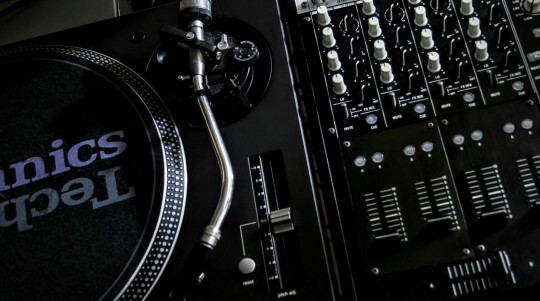
words & Image credit : Eksovichea Tito Hak
Free or inexpensive DJ gear to get the job done... its definitely come a long way since I last checked
It's crazy, I haven't looked into DJ equipment for over 10 years since I exclusively started delving into music production back then, but I was at a place where all my records were stored ('were' being the operative word, since I couldn't find a single piece of vinyl anywhere having spent thousands of dollars on records back then, where I would near ritualistically blow near 80% of my wage on records alone on a monthly basis. Although my two technics turntables were still there, and intact, my backup 4Channel digital hybrid analogue/fully midi assignable Korg Zero4 midi controller was nowhere to be found. In that failed attempt at setting up my DJ rig last night for not being able to find anything, I thought I might as well see where its currently at on the digital front.
Ableton Live
Seems obvious, I used to use it all the time for DJing experimentally after my long foray into using vinyl emulation. Everything else to my mind is just a speed bump as far as DJ equipment is concerned, even CDJ's. The only problem with using Ableton Live though is that you pretty much have to set up a DJ setup work session project within Ableton Live, which can take hours of prep depending how many tunes you want to use (that all need gridding), and what your setup is going to be. It's not simply a case dropping in nay tunes in as you go along. It's not the most affordable option, and would require that you already have Ableton Live (unless you have the pirated version of course). The Ableton Live lite version usually comes free with music hardware, or can be acquired for as little as 20 bucks legit, but it does lack the audio clip manipulation, mix, and remix features that come with the standard, or suite versions of Ableton Live.
Pacemaker DJ device
It's in a box, in pieces. It doesn't work, and was kaput years ago. I didn't want to spend the money on buying another one, especially with having a laptop at my disposal. Surely there must be some laptop software alternatives?
Pioneer WeDJ
In its current form, it's everything that the Tonium Pacemaker DJ device/DJ app should have become on a mobile device for both Android, and iOS. However I don't have a mono headphone monitor, and line out cable splitter on hand, nor could I be bothered ordering one, although I do have one somewhere that I can't find that I bought for the Blackberry Playbook (also now kaput) many years ago. If you have one of Pioneers controllers you can obviously use WeDJ with that instead, which should then give you both stereo pre-mix monitoring, and stereo line outputs to your amp. Pioneer's WeDJ app is completely free to download and use for both Android, and iOS, and is essentially a fully functional DJ app that doesn't require any sort of ongoing subscription for full functionality in order to DJ your music collection.
Native Instruments Traktor DJ 2
Useful if you've got a laptop or a MacBook Pro, and in its most current form is completely free as a fully featured, and highly polished DJ app that functions perfectly for purpose. It's actually shocking how much they actually give you to work with here given that its 100% free from a main competitor commercial brand, but then again with the likes of the open source MIXX DJ app projects giving you way more fully pro features (even a stack of things that many will never even get to using) than this for completely free, I guess they didn't have much of a choice. Although native instruments do have a Pro version of the Traktor DJ app that does come at a premium, which comes with more features than most people would ever even use.
If you don't have a touchscreen to use with it
You'll definitely need an assignable midi controller of some sort to use with it, as well as an audio interface of your own that has a separate set lines for stereo pre-mix monitoring, and stereo line outputs to your chosen amp. Then again, I'm guessing Native Instruments would probably most likely prefer you use one of their midi controllers with it which pretty much gives you a one to one layout. Depending on which you get, there's one with a built in audio interface (which will give you the stereo pre-mix monitor headphones outputs, and separate stereo line outputs you'd more ideally need integrated directly into the midi controller), and one without, but if you were to buy one used from places like eBay, they could be acquired pretty inexpensively for anything between 70 to 150 bucks.
If you have a touchscreen on your laptop
This is probably the ideal, as this gives you the options to 'needle drop', and track scrub via the touch screen, as well as use the controls via the interface, although the GUI controls for the EQ, and pitch within the windows version of Traktor DJ 2 software isn't ideally optimised for touch interactions like it is on the iPad version, but the ability to competently needle drop, and track scrub via the touchscreen, combined with a one of their midi controllers, and an appropriate audio interface would be a killer combination. Something like the Behringer U-Control 222 is great quality as far as its audio is concerned, and can be acquired for around 25 bucks new, However, that won't give you independent headphone pre-mix monitoring, and separate stereo line output compatibility despite the U-Control 222 being equipped with it, where they've most probably rigged it in a way where it Traktor DJ 2 app will only function fully in such a way with one of their own Native Instruments audio interfaces.
MIXX
This has everything that you can find in all the commercial premium DJ application (and more), with compatibility for multiple different vinyl timecode DVS standards too from the numerous different manufacturer brands if you're a vinyl emulation junkie. They've vastly improved the default GUI skin too, that makes it look WAY more professional, and slicker looking than it used to, where it wouldn't look too out of place on a laptop sat next to another laptop maybe running Ableton live on it as part of some sort of sync setup. However, if you're fortunate to have a touchscreen on your laptop, you're a little out of luck here, as it's not really touchscreen interaction friendly optimised, for a fair number of the core control buttons being too small and fiddly on the screen to actually use touchscreen interactions with, so you'll definitely need to have suitable midi controller to assign controls to for this one if you don't want to be stuck using mouse click interactions. Its 100% free to download, and use. It's also the only fully featured DJ app that has a fully functional version for various different builds of Linux too, as well as windows, and MacOS.
RemixLive
It's technically not a DJ app, and if you want to do some fancy stuff with it, it can potentially become quite expensive in order to unlock all its features, but it essentially takes the live remix, and sample based line of approach that Ableton Live can optionally be used for beyond pure music production, and gives it to you within a highly polished, and easy to use touchscreen based application. It's also been created in such a way that you can also use it as a drum machine step sequencer too. You can do some decent stuff with the free features, but if you want to unlock its full potential as an app, you'll have to fork over a fair amount of dough. The app itself is available for both Android, and iOS.
It looks like something from the creators of an app that was originally made for the Novation Launchpad midi controller as a freebie, but greatly further elaborated on, as a separate commercial software product.
There's a lot of potential here…
Using it reminds me of how one might use Ableton Live for stem clip, audio sample based loop music production, but delivered within a very touch based centric package. It's been many years since I last checked it out, and it's certainly come a long way from those plaything like beginnings.
If anything having played with it briefly for a couple of hours earlier this morning via an Android device, with a little more refinement (that’s not to say that it's not actually come a long way since I last briefly looked at it many years ago), it could actually seriously be a much better replacement for the kind of defunct and very expensive Native Instrument stem clip based live remix, and creation controllers, that allows more direct control. It even has full Ableton link sync capabilities within the Android version too. Maybe this was the missing part of development that could have somehow been integrated, and used with something like the stem based Traktor controllers for potential greater success as a product that would have made it less cumbersome in order to simply get things cooking on the fly in a way that's actually fun, and enjoyable without feeling like a chore to get a dancefloor rocking that doesn't require hours, days, or weeks of prep beforehand?
There's a VERY limited selection of free stem packs for it, with the prices for the numerous premium stem packs being very much in line of a chart release track that you might find on Beatport. It's possible to create your own custom combination packs from the packs that you've bought, as well as import your own sample clips too, but they don't make this process as intuitive, or as quick as it could potentially be, as it might be with using something like Ableton Live, or FL-studio mobile for the purposes of creating your own, and using them for quickly putting together a tune off the cuff.
It seems to lack the ability to easily save projects as a separate file save state at any given point which was a little jarring, meaning you need to remember set it up as anew project at the start with its own file name, because if you don't and simply mess with it to come up with something you actually want to save, there's no obvious way to save it that I've found yet.
Touch OSC
If you're a bit strapped for cash, or just simply don't have the space, or need a much more portable fully customisable solution, the traditional midi controller might not be what you're looking for, and particularly if you're limited to android for budget reasons, touch OSC is your friend.
I first came across something like this many years ago, however, back then it was sort of new coming off something called the Jazz Mutant midi controller, which was a dedicated fully customisable midi control surface device, which back then, used to cost a few thousand dollars for the Jazz Mutant control surface device.
However, a few years later, Lemur (the makers of the Jazz mutant) eventually released an iOS app that essentially allowed you to do the same thing with an iPad. I actually got the iPad app, and used it with a hand me down iPad 2 (some time way after the iPad air had been released), and to all intents and purposes it was great, as it did exactly what it said it would do on the tin. I haven't used it since though, nor did I get a replacement iPad after it broke for that specific purpose, since iPads have gotten vastly more expensive where they cost more than a decent laptop these days, and the Lemur app was exclusive to iOS. I never bothered looking into Android solutions, and I do recall seeing touch OSC for android a while back in its very early stages when it was far less user friendly, and limited in features, and wasn't anything like it is today. How is Touch OSC today? The way the application has evolved for Android? It's almost identical to Lemurs Jazz mutant app port to the iPad, with barely any difference. It's perfect for function, and purpose in being incredibly versatile in a DaftPunk wet dream on the command deck of the starship Enterprise kind of way, as it delivers fully customisable midi control surfaces at your fingertips if you have an available Android tablet or smartphone to use it with in conjunction with your chosen DJ software on a MacOS or Windows machine. It's not free, but for such extensive, and powerful features fully unlocked, 12 quid isn't a lot to pay once, and be able to use it as you please for life, for many things, such as any DAW, or DJ app that supports midi. Even if you're using ZeroBug's excellent Touchable Pro app for Ableton Live, you'll still definitely find Touch OSC useful too if you don't want to be moving through layers as often, and have way more room with Touchable for specific control layers always on hand, particularly if you're using VST instruments, synths, and drum machines that are midi control assignable with Ableton Live, but don't have midi control support within Touchable Live pro.
Another sophisticatedly advance multi-tool like feature to add to your smartphone, and or tablet if you often use midi control, that most people would take for granted without knowing of its development, and how its vastly surpassed the capabilities, and versatility of its original high cost premium priced variants…
I suppose this gives you even more incentive to hold onto your old smartphone devices to possibly repurpose them as fully customisable advance modular midi/OSC touch control interface surfaces for your various plugins, and effects modules within your DAW and/DJ software. Obviously beyond midi, as its name suggests, it's all about the OSC, meaning you can also make custom controls for many other things besides DAW, or Video editing software (e.g. national grid powerplant control rooms, etc). Touch OSC running on your Galaxy Tab A7, Tab A8, Tab S6, Tab S7 or iPad 2/3/4 and above via Lemurs original app, whether wired, or more fancy, wirelessly too, it actually provides you with way more advanced features, and capabilities than the original Jazz Mutant controller in a vastly more portable compact device. Even if you had something like an LG V50. V50S, or V60, you'd also be able to plug them into an external touchscreen monitor, and use Touch OSC via the 12/13/14/15 inch touchscreen beyond using it on the actual smartphone device too. You'll probably also find touch OSC very useful to use with MIXX too.
Native Instruments free 'Native Access' apps
'Native Access' is basically their equivalent of the steam app management client, but for all their Native Instruments apps instead. There's mainly premium apps there, but there a number of high quality free apps there too, from synths, instruments, and plugins which you can use as standalone via a midi controller/keyboard, or as a VST plugin for you chosen DAW. Simply do a search for the their free apps on their website.
One app that you won't find there though (although you will need to enter the serial number for it within the Native access client to actually register, and download it after first install the Native Instrument Reaktor 7 player app), is the DP-06+ app, which is basically a faithfully recreated software version of the Roland 606 drum machine that you use like a VST plugin via Reaktor 7. Just head on over to 'Deputi Sounds' where you can buy it for a limited period for the price of $0.00 (you actually have to go through the checkout process to get the activation serial number code for it). I don't know how long the offer is on for, but the temporary offer rolled out yesterday.
1 note
·
View note
Text
Brian Eno on New Technology and the Future of Music

Brian Eno, the British electronic producer and ambient legend, discusses how he uses music technology in new and unconventional ways to inspire his creativity. He emphasizes the importance of discovering what gear can do beyond its intended purpose and how technology like 3D audio opens up new production possibilities. Eno also highlights the excitement of unexpected synergy in music creation.
Brian Eno is a British musician, record producer, singer, songwriter, and visual artist. He is one of the most influential and innovative musicians of the last 50 years, and his work has had a profound impact on a wide range of genres, including ambient music, electronic music, and rock music.
In a recent op-ed for the Financial Times, Eno wrote about his love of new technology and how it has inspired him throughout his career. He also talked about his excitement about 3D audio and the new possibilities it opens up for music creation.
"Most equipment is invented to do an existing job faster, or cheaper, more cleanly, or more easily," Eno wrote. "What I like to do is to discover what you can do with it that isn't historical – something that it wasn't designed for, something new."

Eno went on to give examples of how he has used new technology in innovative ways throughout his career. For example, he was one of the first musicians to use synthesizers and other electronic instruments. He also pioneered the use of sampling and other digital recording techniques.
In recent years, Eno has been excited about the potential of 3D audio. 3D audio is a new way of recording and playing back music that creates a more immersive listening experience. Eno believes that 3D audio has the potential to revolutionize the way we listen to music.
"It turns out that our ears are much more directional than we usually allow for," Eno wrote. "Working in 3D as opposed to stereo (which is how we have been listening to recorded music until recently) it’s possible to have much more, and more subtle, information. You can hide things in corners for people to find. You can make the listener’s movements a way of “mixing” the piece."

Eno is currently working on a new album that will feature 3D audio. He is also developing a new software program that will allow musicians to create their own 3D audio recordings.
Eno's excitement about new technology and 3D audio is infectious. He is a true pioneer in the field of music technology, and his work continues to inspire new generations of musicians.
In a recent interview with MusicTech, Eno talked about his plans for the future and how he sees 3D audio playing a role in his music.
"I'm interested in exploring the possibilities of 3D audio," Eno said. "I think it has the potential to be a very powerful tool for creating immersive and engaging musical experiences. I'm also interested in developing new ways to use 3D audio in live performances."

Eno's work with 3D audio is still in its early stages, but he is already excited about its possibilities. He believes that 3D audio has the potential to revolutionize the way we listen to music, both at home and in live settings.
"I think 3D audio has the potential to be a major step forward for music listening," Eno said. "It's a new way to experience music, and I think it's going to be very exciting to see how people use it in the future."
Find out more at brian-eno.net.
0 notes
Text
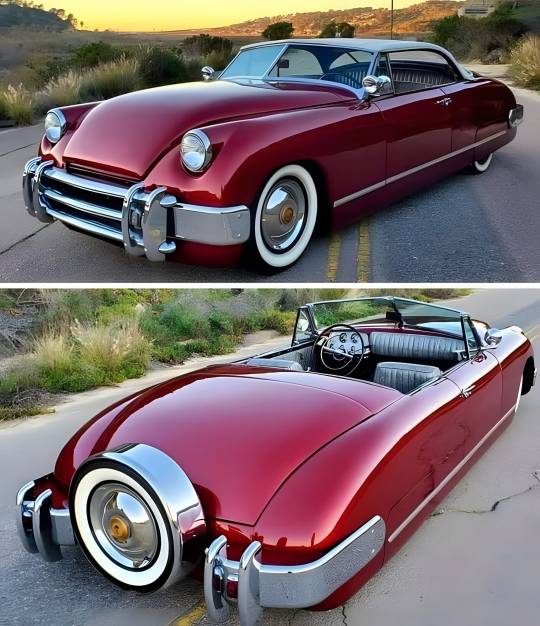
Custom 1953 Muntz Jet Convertible
This 1953 Muntz Jet convertible underwent a three-year custom build under previous ownership, and it was purchased by the seller in 2021. The car is powered by a fuel-injected 5.7-liter LT1 V8 engine paired with a four-speed automatic transmission and a Ford 9″ rear end, and it is finished in Apple Pearl with a white Carson-style removable top over gray snakeskin-style Naugahyde upholstery. Features include custom bodywork, an Art Morrison frame, power-assisted steering, four-wheel disc brakes, airbag suspension, Painless Performance wiring, and more modified and fabricated details. This custom-built Muntz is now offered with a copy of Rodder’s Journal magazine featuring a story on the build and a clean California title in the name of the seller’s business.
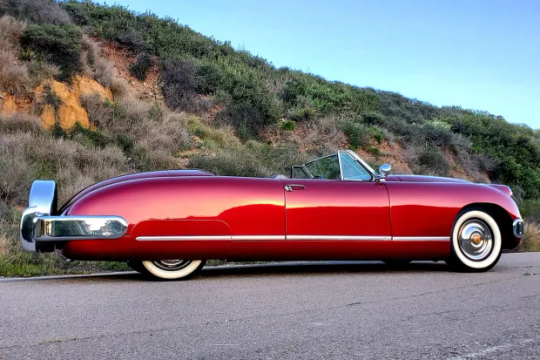
Custom 1953 Muntz Jet Convertible
The steel, aluminum, and fiberglass body is mounted on an Art Morrison ladder frame that was boxed and finished in semi-gloss black, and the floor was raised 3″. The exterior was repainted in a Sherwin Williams two-stage Apple Pearl mixed by the late Stan Betz. Features include a chopped Duvall-style windshield, 1950 Chevrolet headlights, dual Appleton spotlights, 1951 Ford Victoria side windows, and a white removable Carson-style top fabricated to match the height of the chopped windshield. Additional equipment includes color-matched rear fender skirts and chrome bumpers. Wear from fitting the top is noted on the rear deck.

Custom 1953 Muntz Jet Convertible
Steel wheels sourced from a 1976 Dodge measure 15″ and are mounted with Cadillac Sombrero-style covers and whitewall tires. A matching spare fitted with a BFGoodrich Silvertown tire is mounted within a rear-mounted Continental-style chrome carrier. A Mustang II front end accommodates power rack-and-pinion steering , and the car rides on an electronically-adjustable Air Ride Technologies airbag suspension system along with 2” lowered front spindles, Strange Engineering tube shocks, a rear Panhard bar, and front and rear sway bars. The seller reports that the front control arm bushings were recently replaced.
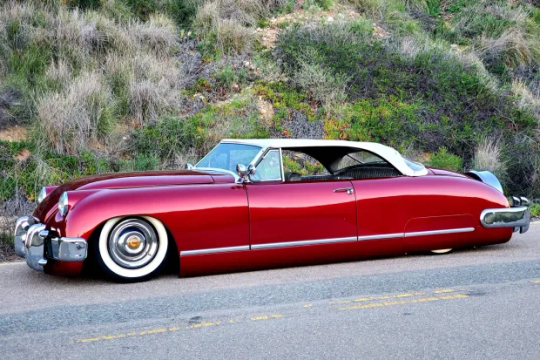
Custom 1953 Muntz Jet Convertible

Custom 1953 Muntz Jet Convertible
Braking is handled by GM G-body-sourced calipers matched with Ford Granada discs up front and Ford SVO-specification calipers and discs at the rear.
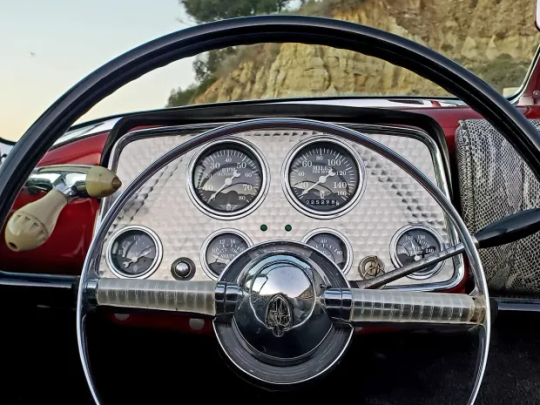
Custom 1953 Muntz Jet Convertible
The cabin was customized by Jim’s Auto Trim of San Diego, California, and features Glide bucket seats and a rear bench trimmed in gray snakeskin-style Naugahyde upholstery, along with matching treatments for the dash trim, headliner, and door panels. Additional equipment includes a 1952 Lincoln steering wheel mounted to a shortened Lincoln steering column, gray cut-pile carpet, and a Pioneer stereo housed within a custom center cubby.
The engine-turned “Hollywood” instrument cluster houses Stewart Warner gauges consisting of an 8k-rpm tachometer, a 160-mph speedometer, and auxiliary readings for fuel level, battery charge, oil pressure, and water temperature. The five-digit odometer displays 25k miles, though total chassis mileage is unknown. A Lokar pedal assembly was fitted during the build.
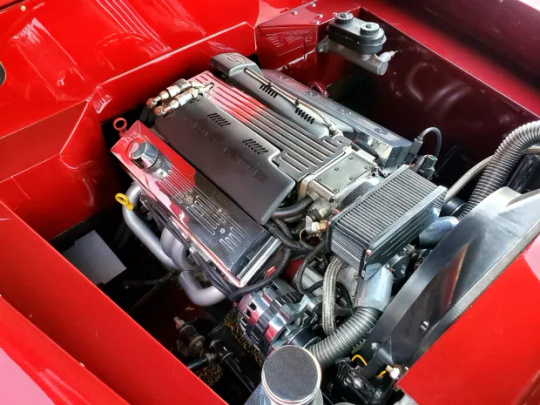
Custom 1953 Muntz Jet Convertible
The Corvette-sourced 5.7-liter LT1 V8 features a polished fuel intake manifold along with billet aluminum valve covers, and additional features include an Opti-Spark distributor, a Griffin aluminum radiator, and a wiring loom sourced from Painless Performance Wiring. A set of long-tube headers are connected to a 2.5″ exhaust system equipped with dual Dynaflow mufflers. The seller reports that the oil was recently changed.
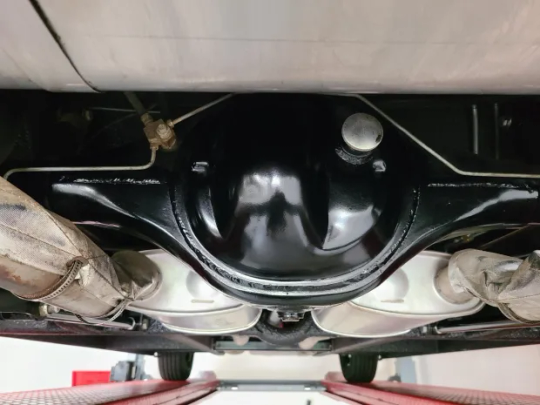
Custom 1953 Muntz Jet Convertible
Power is routed to the rear wheels via a four-speed 4L60E automatic transmission and a Ford 9″ rear end with with 3.55:1 gears and Strange Engineering 31-spline axles. Additional photos of the underside, drivetrain, and suspension components are presented in the gallery below.
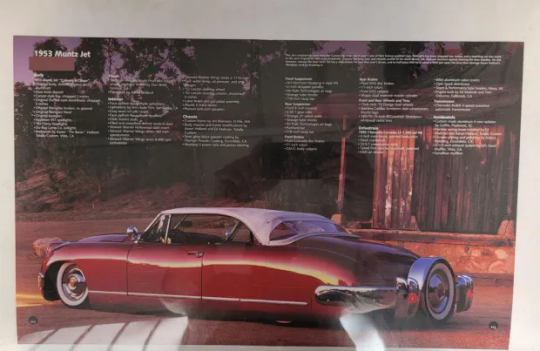
Custom 1953 Muntz Jet Convertible
The car was featured in issue #36 of Rodders Journal magazine
#Custom 1953 Muntz Jet Convertible#Custom 1953 Muntz Jet#Muntz Jet Convertible#Custom Muntz Jet Convertible#Muntz Jet#Convertible#car#cars#muscle car#american muscle
110 notes
·
View notes
Text
The development of party sound systems
Introduction
There is a proverb that states "music is life." Additionally, music is the lifeblood of any celebration. Party sound systems have developed throughout history to become bigger, better, and more powerful than ever before, from high school dances to sizable outdoor festivals. See how party sound systems have evolved throughout time, from basic models to cutting-edge wonders that will make your chest pound with bass and leave you gasping for air.

Party sound system history
Party DJ Hire Sydney sound systems were created as a result of disco. In the 1970s, DJs used records to make seamless mixes that could be played nonstop in clubs. Disco turntables, which were modified tape decks, were created as a result. DJs began utilizing these turntables to make beats and melodies, which they then combined with other music performed in the club to produce a distinctive sound.
House parties and raves later adopted it. DJs started merging tracks from different albums into lengthier mixes known as "sets," where rhythms and melodies were made with CDs and LPs rather than tapes. Synthesizers and other electronic instruments could be used to create a tone that is more modern. DJs began creating extended mixes, or "sets," out of tracks from different albums as house music gained popularity.
As electronic dance music (EDM) gained popularity in the late 1990s and early 2000s, DJs began employing digital audio workstations. (DAWs). DJs were now able to experiment with sounds that weren't achievable with more traditional DJ techniques. DJs now have new tools for editing, remixing, and altering sounds thanks to digital audio workstations (DAWs).
Various Party Sound System Types
Party sound systems have advanced significantly from their bulky, ineffective forebears to become sleek, portable, and versatile in their capacity to replicate a range of noises.
A portable sound system is ideal for bringing your music with you wherever you go. Because of their small size and light weight, they are frequently portable. Some versions don't require external speakers or audio inputs because they come with built-in speakers.
For events like weddings, anniversaries, and bar/bat mitzvahs, the most recent in-home cinema sound systems are perfect. The integrated high-powered speakers and several amplification choices can handle even the noisiest groups
Additionally, many home entertainment systems can decode Dolby Digital and DTS to create high-quality audio files that can be played on the majority of DVD and Blu-ray players.
In places like schools and churches, public announcement systems are standard. Despite their size and strength, they don't require a significant initial investment because of their inexpensive cost. Most public address systems offer microphone inputs so that users can plug in microphones.

Party sound system technology
Technology has recently had an impact on the planning and management of party sound systems. The following technologies are some of the ones that are currently most frequently utilized in party sound systems:
1 DJ Software
Traktor, Serato, and Pioneer DJ Pro are some of the most well-known DJ software packages that enable users to mix tracks and adjust the sound to match the party's mood.
2. Audio Gear
Rich sounds can only be produced in a party setting with audio equipment. Turntables, CD players, and mixer boards are among the most frequently utilized pieces of audio equipment. Vinyl records, which can produce deep bass tones, are frequently played on turntables. High-quality stereo CDs can be played on CD players. DJs may generate complicated sounds and beats on stage by using mixer boards, which enable them to manipulate many audio sources with a single controller.
3. Lighting and Decorations
Two of the most crucial components of a great party are the lighting and the decorations. It is effective at fostering a festive environment or enhancing the gravity of a grave occasion. Party sound systems are typically combined with lighting effects like strobes, lasers, and fog machines. There are numerous additional typical celebration decorations in addition to balloons, streamers, and confetti.
How to Pick the Right Party Sound System
One of the many things to take into account when choosing the ideal party sound system for your event is how loud it needs to be. Please be specific about the type of music you like. Do you prefer an autonomous music system over a public address system? You may choose the greatest party sound system for your future event by adhering to these recommendations.
How Much Volume Is Needed?
The type of music being played and the size of the space will affect the sound system's volume. In a smaller arena, playing classic rock could only require 75–80 dB, whereas a larger one might require up to 100 dB. Verify with the venue that everything is legal and secure before booking a reservation.
What about some music? What do you prefer?
Choose the music genre you want to play, as well as the sound system's volume level. Any type of music can be played on a party system, however some genres are better suited to certain arrangements than others. While country music is played over a public address system, electronic dance music is transmitted using specialized DJ Hire systems designed for nightclubs and bars. You can look out specific party systems that support a particular musical genre once you've decided on it.
Earlier Party Sound Systems
Early 20th-century sound systems were typically big, complicated machinery that required lots of personnel to run. These devices were frequently deployed in music venues like nightclubs.
In recent years, portable and lightweight sound systems have grown more readily available, making them ideal for use at outdoor gatherings like festivals.
Due to the vast price range (from $100 to $5,000+) and the wide number of brands now available on the market, it might be difficult to choose a party sound system that suits your needs and budget.
The future of party sound systems
As audio technology advances, the future of party sound systems looks bright. We examine the benefits and drawbacks of five of the most popular party music systems on the market right now.
DJI Mavic Air's party sound equipment is highly sought after. The Mavic Air is perfect for recording and producing audio because it has two speakers and a microphone. It is a portable, lightweight setup that can be utilized both indoors and outdoors.
Due to its portability, the DJI Mavic Air is a fantastic choice for events like weddings and birthday parties. It is also suitable for usage in limited locations due to its small design.
The DJI Mavic Air is very affordably priced. It is one of the most affordable drones on the market, making it a desirable choice for those in charge of organizing events on a low budget. However, the DJI Mavic Air's audio performance isn't as good as some other systems that are now available.
0 notes